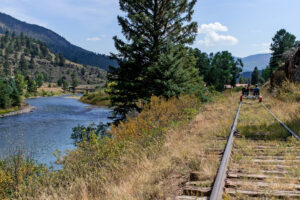
EARLY MORNING, BEFORE the sun even hinted at dawn, I walked the dog along our suburban sidewalk, with numerous streetlights illuminating our way. I spotted movement ahead — a sizable four-legged form padding silently away, a long tail draped in a graceful curve nearly touching the ground. That’s all I saw but I didn’t need more — a mountain lion! We stopped; the critter continued away; we backed up slowly and headed straight home. Walk is over!
The mountain lion goes by many names: cougar, puma, panther, catamount, to name a few. By far the largest wild cat in the U.S. (except for the occasional jaguar that slinks in from Mexico), this big cat is tawny to reddish brown with paler underparts. Its scientific name — Felis concolor — means “one-color cat.” But really, it’s “one color” only in the sense that it doesn’t have stripes or spots, as other big cats of the world do. Following the S curve of its hind end to just above the ground, the cat’s distinctive tail is long, cylindrical and black-tipped. The backs of its ears are also black. A mountain lion’s eyes are proportionally larger than other local carnivores’ eyes. Close together and facing forward, they allow sharp binocular vision, superb depth perception and the ability to judge distance precisely. Males are 30-40% larger than females, with Colorado cats among the largest representatives of the species.
Mountain lions boast the widest geographical range of any extant land mammal in the New World, ranging from the Yukon to Tierra del Fuego. They once inhabited all of the conterminous U.S., but European colonists extirpated most groups in the East and Midwest. Unlike wolves and grizzlies, though, mountain lions hid well in the rocky West; moreover, their preference for hunting over scavenging protected them from poison and traps. Today, roughly 30,000 wander the West—estimates between 4,000 and 5,000 in Colorado, mostly unseen—overlapping with people nearly everywhere (including the suburbs, as my dog and I can attest). In Colorado, the species is common in much of the western part of the state and increasingly reported in more rugged areas of the eastern plains. They prefer rough, broken foothills and canyon country, often around montane forests and pinyon-juniper woodlands. (I’m looking at you, PJ-rich Fremont County.)
Mountain lions have no set breeding period; females can come into estrus in any season. In Colorado, litters of two or three kittens (on average) are born mostly in spring and summer. Kits remain in the den five weeks and nurse for approximately two months; at about six months, their eyes begin to turn from blue to brown or amber. When pushed out on their own between 14 and 24 months old, the juveniles roam in search of suitable, unoccupied territories. These teenagers often get in trouble by wandering into human-occupied areas and preying on pets or livestock.
Active at night or within an hour or two of dawn or dusk, the cats generally rest during mid-day in sheltered locations such as in a canyon or under trees and brush. Luckily, most mountain lions want little to do with humans. Even close to homes, they heavily favor wild prey over easier-to-catch domestic animals. Very few, predominantly females with young, even make threat responses to a human’s presence. Studies have shown they often flee from hard-won kills at the mere sound of a human voice.
In North America, mountain lions prey mainly on deer, although they can take other large mammals including elk, moose, cattle, sheep (both wild and domestic) and smaller prey (e.g., ground squirrels, raccoons, bobcats). Solitary hunters, they rely on stealth rather than chase, moving frequently and waiting in ambush. Padded feet allow them to stalk silently.
In 2016, a decline in mule deer numbers prompted U.S. Fish and Wildlife (USFWS) and Colorado Parks and Wildlife (CPW) to begin testing the theory in the Salida and Rifle areas that “fewer predators results in more mule deer.” The Upper Arkansas River Plan (Salida) proposed that CPW remove 15% of the area’s mountain lions annually over nine years. Unfortunately, predators are likely the least of the deer problems. Chronic wasting disease has infected up to 20% of deer herds, dropping numbers by 1/3 statewide—from 614,000 for 418,00—over the last 15 years. Oil/gas drilling and housing development have degraded deer habitat, but CPW can’t preserve habitat to counteract this major threat to all wildlife. Facing considerable public opposition, CPW stated that hunting is one of its best tools for managing wildlife; hunting/fishing also provides nearly 45% of CPW’s annual budget. Yet independent research has shown sport hunting to be an ineffective approach to successfully managing wildlife long-term. The plan’s final blow fell in March 2021, when a federal judge ruled that USFWS violated the National Environmental Policy Act by funding it without completing its own environmental analysis. Further, the court found the environmental analysis USFWS tried to rely on didn’t adequately analyze the impacts of the plan either. The Upper Arkansas River Plan was subsequently halted.
As top-level ecosystem engineers, mountain lions help enhance worlds. A mountain lion kills an average of one deer every 7?10 days. By keeping deer moving and populations trimmed, the cats ensure that vegetation thrives by preventing excessive grazing and browsing. Because it eats only 5?10 pounds per day, a cat caches a carcass for prolonged feeding. At least 275 species utilize this stored food. Once the vertebrate scavengers (e.g., foxes, coyotes, Turkey Vultures, Common Ravens) have their fill, invertebrates such as flies, beetles and ants take over. No scrap left behind.
Often the only evidence of a mountain lion’s presence will be tracks, easiest to see in the winter snows. Tracks show four toes with no claw marks spread over a large, lobed heel pad. (Cats retract their claws when walking.) So this winter, look for snow prints alerting you to the passing of this stealthy, mysterious, magnificent feline.



